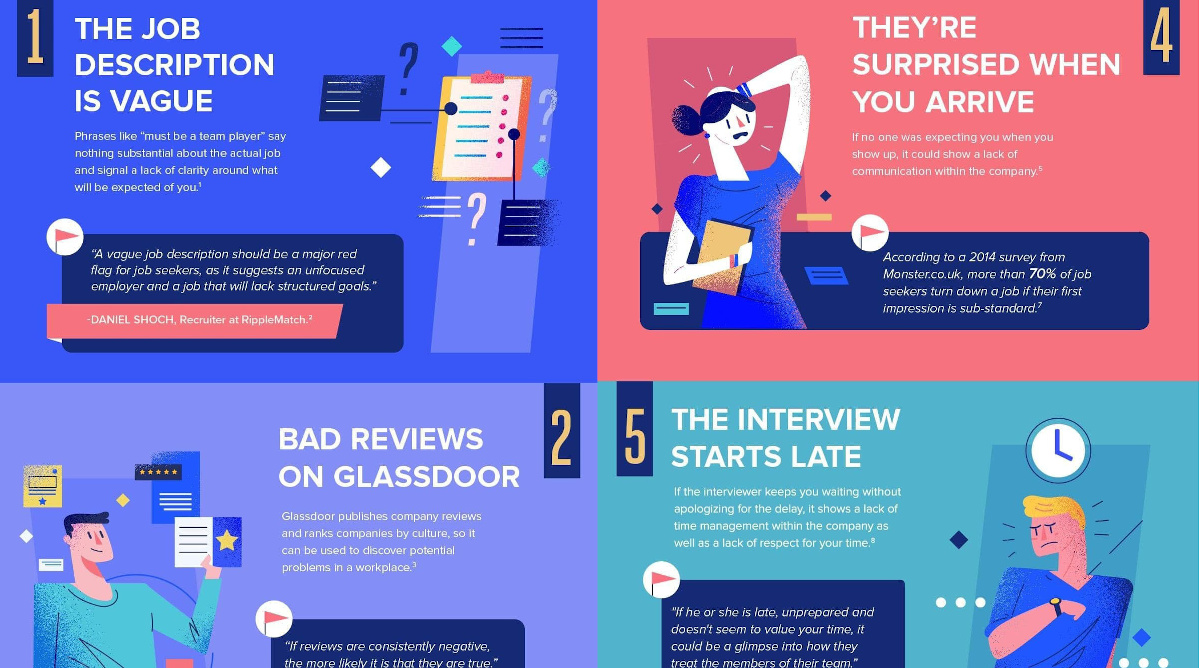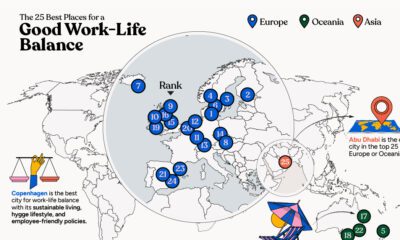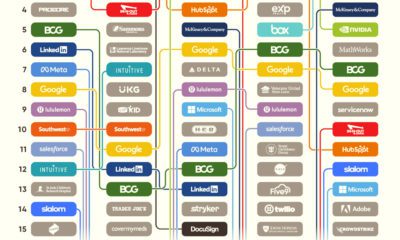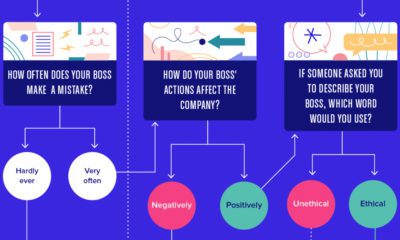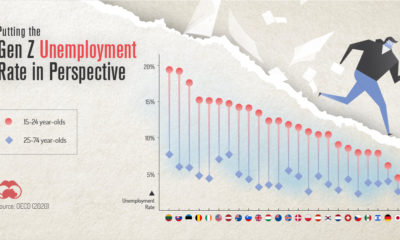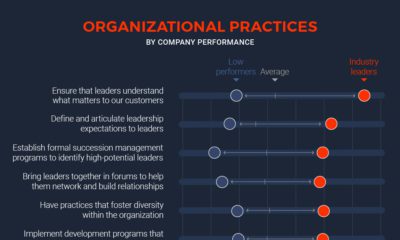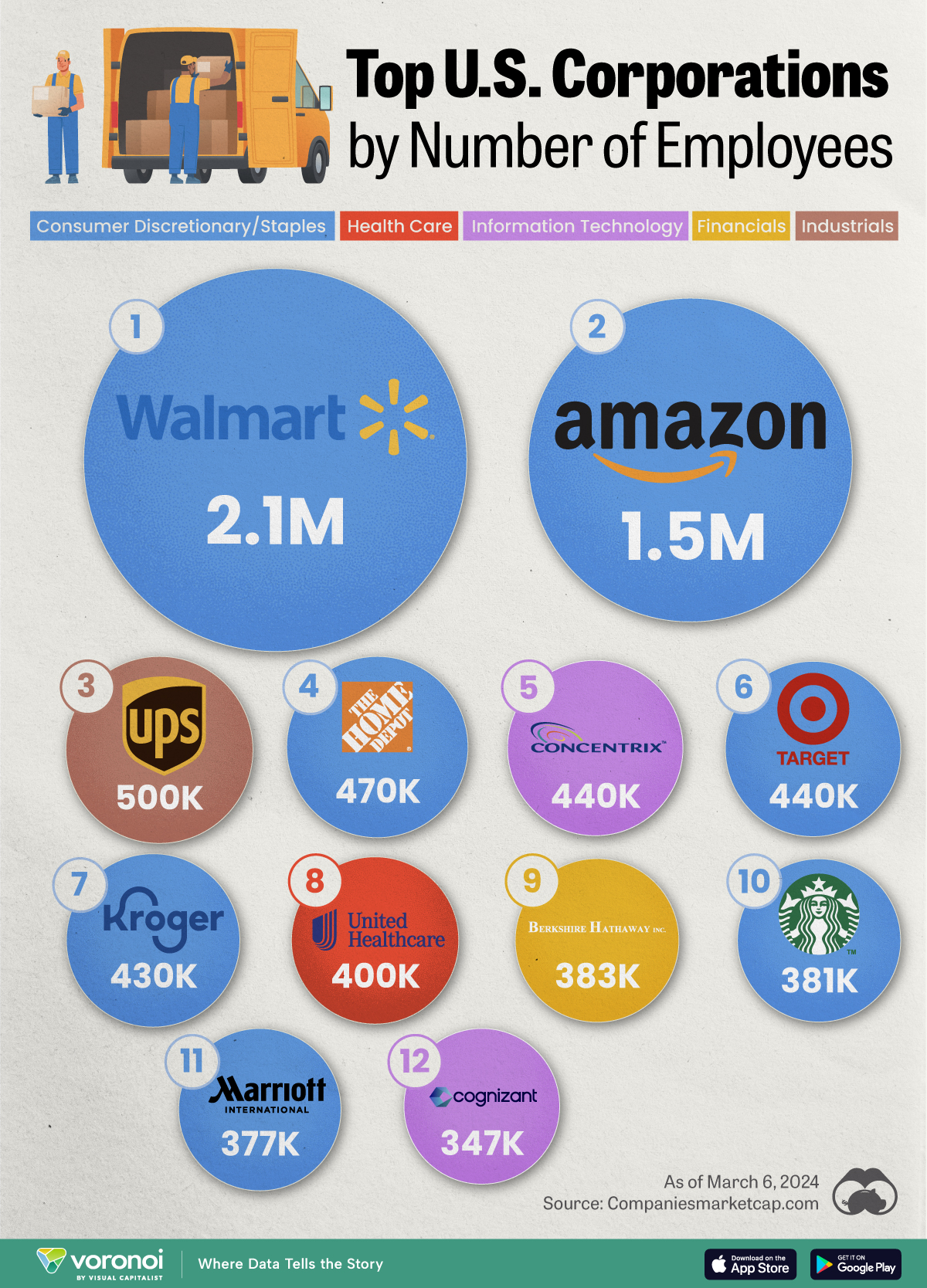Business
15 Warning Signs to Identify a Toxic Work Environment Before Taking a Job
According to Gallup, 85% of the world’s one billion full-time employees are unhappy at work.
While there are a number of reasons that contribute towards job dissatisfaction, a toxic work environment can have a significant impact on an employee’s performance, not to mention their physical and mental health.
But identifying red flags before accepting a job offer can be difficult; companies often sell themselves as a model workplace, when in reality, their inner workings are hugely problematic.
How to Identify a Toxic Work Environment
Today’s graphic comes to us from resume.io and it illustrates the 15 warning signs to look out for before, during, and after a job interview.

Lifting the Corporate Veil
A toxic work environment diminishes productivity by breeding a culture of discrimination, disorganization, bullying, and may even be fueled by unethical or selfish motivations.
Luckily, prospective employees can avoid 40 hours of torment a week by probing the company’s culture before signing on the dotted line. Here is a list of things to look out for:
Before the Interview
For better or worse, first impressions matter. Although excitement levels may be high, it’s important to pay attention to potential missteps, even before the interview starts.
- Vague job description: There should be clarity around the roles and responsibilities associated with the job, even if it is a new role in the company.
- Negative reviews on Glassdoor: Company review platforms are quickly becoming an indispensable tool for jobseekers who are interested in learning more about previous and current employees’ experiences.
- It took a long time to arrange an interview: Companies should show respect for the interviewee by getting back to them in a timely manner.
- Forgetting interviews: This could suggest that either the company has serious communication issues, or they do not prioritize interviewing potential employees.
- The interview starts late: Punctuality is not only expected from the person being interviewed, the interviewer should also be on time.
During the Interview
Adrenaline may be pumping when the interviewee is in the hot seat, but it’s crucial that they take stock of how the interviewers are conducting themselves.
- Unprepared interviewers: If the interview lacks structure, this could signal a disorganized team and a lack of clear expectations for the role.
- No interest in listening: Both parties need to put their best foot forward in an interview, to make sure that the interviewee’s personality and skill set aligns with the company, and vice versa.
- Authoritarian interviewer: This may indicate a lack of respect for employees.
- Inability to communicate company values: If company values are embodied by employees, then they should be top of mind and easily communicated.
- Questions are skimmed over: Companies should be transparent and be willing to provide comprehensive answers to any questions an interviewee may have.
After the Interview
In addition to assessing their own performance, interviewees should give careful consideration to how the entire interview experience went.
- Short interview: Either the company has already chosen another candidate, or they are desperate to fill the role as quickly as possible.
- Quiet workspace: A lack of teamwork or fearful employees could be the culprit for a silent office.
- No office tour: Companies should always give prospective employees a glimpse into what their day-to-day could look like by showing them around and introducing them to the team.
- Job offer was given on the day of the interview: The company could be trying to restrict the interviewee doing further research into the company, or simply filling the role as quickly as possible.
- Delayed decision-making: Failing to get back to someone who has done an interview shows a lack of respect for their time or disorganization on the company’s end.
It’s also worth mentioning that mistakes can be made by anyone, so it is perhaps not helpful to scrutinize companies for small errors in judgement when most of the experience has been positive.
Regardless, if there are any looming uncertainties, it is up to the person being interviewed to ask.
Finding the Courage to Ask Questions
When it comes to interviews, questioning the culture of the company is just as important as questioning the interviewee on their knowledge and skills.
“He who asks a question may be a fool for five minutes. He who does not ask questions, remains a fool forever.”
—Ancient Chinese proverb
Switching jobs is rarely an easy process, especially when jobseekers have come up against unforeseen challenges as a result of COVID-19.
But it is more important than ever for people to do their due diligence, and be brave enough to ask tough questions. Otherwise, they may have to repeat the cycle all over again—much sooner than they would have thought.
Markets
Ranked: The Largest U.S. Corporations by Number of Employees
We visualized the top U.S. companies by employees, revealing the massive scale of retailers like Walmart, Target, and Home Depot.
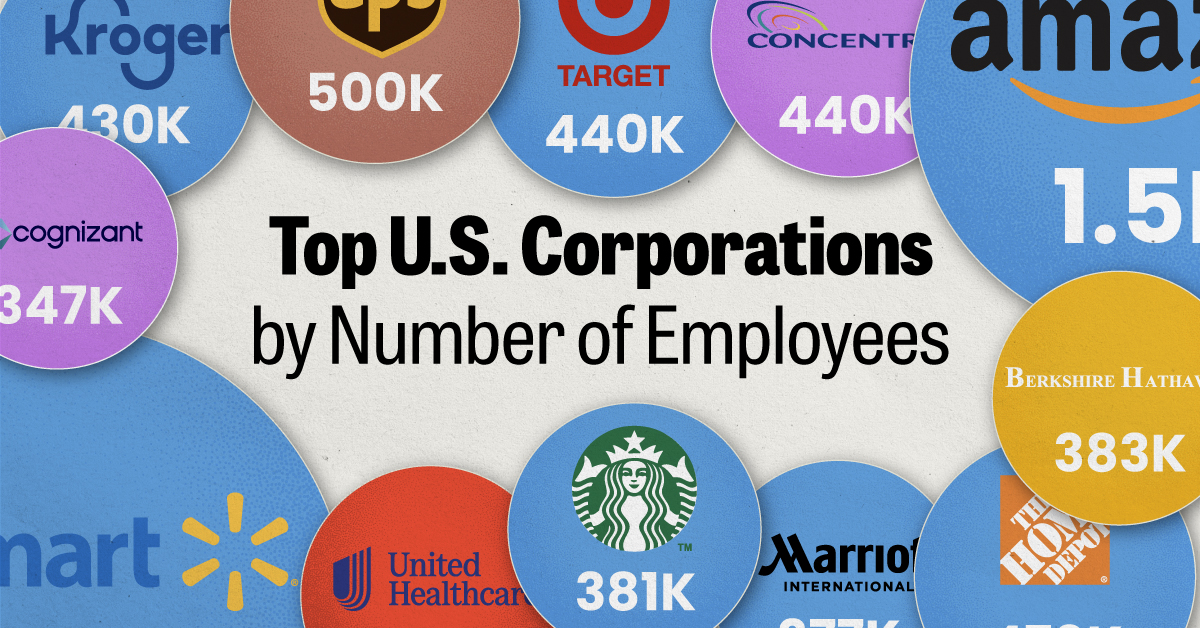
The Largest U.S. Corporations by Number of Employees
This was originally posted on our Voronoi app. Download the app for free on Apple or Android and discover incredible data-driven charts from a variety of trusted sources.
Revenue and profit are common measures for measuring the size of a business, but what about employee headcount?
To see how big companies have become from a human perspective, we’ve visualized the top U.S. companies by employees. These figures come from companiesmarketcap.com, and were accessed in March 2024. Note that this ranking includes publicly-traded companies only.
Data and Highlights
The data we used to create this list of largest U.S. corporations by number of employees can be found in the table below.
| Company | Sector | Number of Employees |
|---|---|---|
| Walmart | Consumer Staples | 2,100,000 |
| Amazon | Consumer Discretionary | 1,500,000 |
| UPS | Industrials | 500,000 |
| Home Depot | Consumer Discretionary | 470,000 |
| Concentrix | Information Technology | 440,000 |
| Target | Consumer Staples | 440,000 |
| Kroger | Consumer Staples | 430,000 |
| UnitedHealth | Health Care | 400,000 |
| Berkshire Hathaway | Financials | 383,000 |
| Starbucks | Consumer Discretionary | 381,000 |
| Marriott International | Consumer Discretionary | 377,000 |
| Cognizant | Information Technology | 346,600 |
Retail and Logistics Top the List
Companies like Walmart, Target, and Kroger have a massive headcount due to having many locations spread across the country, which require everything from cashiers to IT professionals.
Moving goods around the world is also highly labor intensive, explaining why UPS has half a million employees globally.
Below the Radar?
Two companies that rank among the largest U.S. corporations by employees which may be less familiar to the public include Concentrix and Cognizant. Both of these companies are B2B brands, meaning they primarily work with other companies rather than consumers. This contrasts with brands like Amazon or Home Depot, which are much more visible among average consumers.
A Note on Berkshire Hathaway
Warren Buffett’s company doesn’t directly employ 383,000 people. This headcount actually includes the employees of the firm’s many subsidiaries, such as GEICO (insurance), Dairy Queen (retail), and Duracell (batteries).
If you’re curious to see how Buffett’s empire has grown over the years, check out this animated graphic that visualizes the growth of Berkshire Hathaway’s portfolio from 1994 to 2022.
-

 Green2 weeks ago
Green2 weeks agoRanked: Top Countries by Total Forest Loss Since 2001
-

 Travel1 week ago
Travel1 week agoRanked: The World’s Top Flight Routes, by Revenue
-

 Technology1 week ago
Technology1 week agoRanked: Semiconductor Companies by Industry Revenue Share
-

 Money2 weeks ago
Money2 weeks agoWhich States Have the Highest Minimum Wage in America?
-

 Real Estate2 weeks ago
Real Estate2 weeks agoRanked: The Most Valuable Housing Markets in America
-

 Markets2 weeks ago
Markets2 weeks agoCharted: Big Four Market Share by S&P 500 Audits
-

 AI2 weeks ago
AI2 weeks agoThe Stock Performance of U.S. Chipmakers So Far in 2024
-

 Automotive2 weeks ago
Automotive2 weeks agoAlmost Every EV Stock is Down After Q1 2024

